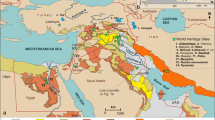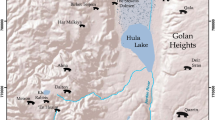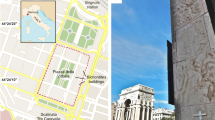Abstract
Valencina (Seville, Spain) is one of the most important megalithic sites of the third millennium BCE in Western Europe. Among its most celebrated monuments are the tholoi of Montelirio, La Pastora, Matarrubilla, and Structure 10.042-10.049. Although sharing the same architectural tradition, these monuments were raised at different times of Valencina’s history and present important formal differences. In particular, the tholoi of La Pastora and Matarrubilla contrast with that of Montelirio in that they are devoid of artistic ornamentation such as paintings and engravings, showing instead an inordinate number of natural geological features. This study, focusing on La Pastora and Matarrubilla, offers an innovative approach to the notion of “megalithic art.” Firstly, these elements are characterized and classified and their natural origin established. Thus, the calcareous sandstone blocks dated from the Tertiary reveal structures on their surfaces generated by biological (bioturbation) and physical (by currents) processes during the Neogene. The surfaces of certain slabs of identical lithology at La Pastora experienced more recent intense marine bioerosion and bioconstructions in the form of Ostrea preserved to this date. Secondly, we emphasize the choice of different rock types following a certain pattern or serving to highlight a particular constructive element. In sum, all the natural elements bear highly aesthetic qualities and appear to have been deliberately chosen to highlight specific decorative or symbolic aspects. As a result, we suggest that future research on “megalithic art” should include analogous geological examinations in order to discern the origin and nature of the different elements.















Similar content being viewed by others
References
Alburquerque e Castro A, da Veiga FO, Viana A (1957) O dolmen pintado de Antelas (Oliveira de Frades). Comunicaçoes dos Serviços Geológicos de Portugal 325–247
Allen JRL (1970) Physical processes of sedimentation. George Allen & Unwin, London
Allen JRL (1982) Sedimentary structures. Their character and physical basis. Developments in sedimentology V 30. Elsevier Science Publisher, Amsterdam
Almagro M (1966) Las Estelas Decoradas del Suroeste Peninsular. CSIC, Madrid
Almagro M, Arribas A (1963) El Poblado y la Necrópolis Megalítica de Los Millares (Santa Fé de Mondújar. Almería). Bibliotheca Praehistorica Hispana 3, Madrid
Aranda G, Lozano JA, Pérez-Valera F (2017) The megalithic necropolis of Panoria, Granada, Spain: geoarchaeological characterization and provenance studies. Geoarchaeology 33:260–270
ACAM (Asociación Cultural Arqueológica Mataherrera) (2002) Yacimiento Arqueológico. Valencina. Caja San Fernando, Sevilla
Bevins RE, Ixer RA (2013) Carn Alw as a source of the rhyolitic component of the Stonehenge bluestones: a critical re-appraisal of the petrographical account of H.H. Thomas. J Archaeol Sci 40:3293–3301
Belaústegui Z, Muñiz F, Nebelsick JH, Domènech R, Martinell J, Zamora S, Rahman IA (2017) Echinoderm ichnology: bioturbation, bioerosion and related processes. J Paleontol 91(4):643–661
Beltrán A (1983) El arte esquemático en la Península Ibérica: orígenes e interrelaciones. Bases para un debate Zephyrus 36:37–41
Boaventura R (2000) A geologia das Antas de Rabuje (Monforte, Alentejo). Rev Port Arqueol 3(2):15–24
Borja F, Borja C (2016) Los materiales constructivos pétreos de Montelirio. In: Fernández A, García-Sanjuán L, Díaz-Zorita M (eds) Montelirio. Un gran monumento megalítico de la Edad del Cobre. Arqueología Monografías, Junta de Andalucía, Consejería de Cultura, Sevilla, pp 143–163
Bosch P (1965) La chronologie de l’art rupestre seminaturaliste et schémathique et la culture mégalithique portugaise. Revista da Faculdade de Letras (Lisboa), III serie, 9
Breuil H (1935) Les peintures rupestres schématiques de la Péninsule ibérique. Lagny, Paris
Breuil H (1940) Quelques observations sur les peintures rupestres schématiques de la péninsule Ibérique. I Congresso do Mundo Portugués, Lisboa, pp 253–264
Bromley RG (1970) Borings as trace fossils and Entobia cretacea Porlock as an example. In: Crimes TP, Harper JC (eds) Trace Fossils. Geol J (Special issue 3): 48–90
Bromley RG (1990) Trace fossils: biology and taphonomy. Special topics in palaeontology 3. Unwin Hyman, London
Bromley RG, Frey RW (1974) Redescription of the trace fossil Gyrolithes and taxonomic evaluation of Thalassinoides, Ophiomorpha and Spongeliomorpha. Bull Geol Soc Den 23(3–4):311–335
Buatois LA, Mangano GM (2011) Ichnology. Organism-substrate interactions in space and time. Cambridge University Press, New York
Bueno P (1995) Megalitismo, estatuas y estelas en España. Statue-stele e massi incisi nell’Europa dell’etá del Rame, Notizie Archeologiche Bergomensi 3:77–130
Bueno P, Balbín-Behrmann R (2000) Arte megalítico versus megalitismo: origen del sistema decorativo megalítico. In: Gonçalves VS (Ed) Muitas antas, pouca gente? Actas do I Colóquio Internacional sobre Megalitismo, Trabalhos de Arqueologia 16:283–302
Bueno P, Balbín-Behrmann R, Barroso R (2009) Pintura megalítica en Andalucía. In: Estudios de Prehistoria y Arqueología en Homenaje a Pilar Acosta Martínez. Universidad de Sevilla, Sevilla, pp 141–170
Bueno P, Balbín-Behrmann R, Barroso R (2016a) Megalithic art in the Iberian Peninsula thinking about graphic discourses in the European Megaliths. In: Fonctions, utilisations et représentations de l’espace dans les sépultures monumentales du Néolithique européen, Préhistoires de la Méditerranée, Colloque 2014. Presses Universitaires de Provence, Aix-en-Provence, pp 185–203
Bueno P, Balbín-Behrmann R, Barroso R, Carrera F, Hunt MA (2016b) El arte y la plástica en el tholos de Montelirio. In: Fernández A, García-Sanjuán L, Díaz-Zorita M (eds) Montelirio. Un gran monumento megalítico de la Edad del Cobre, Arqueología Monografías, Junta de Andalucía, Consejería de Cultura, Sevilla, pp 365–405
Buck CE, Kenworthy JB, Litton CD, Smith AFM (1991) Combining archaeological and radiocarbon information—a Bayesian-approach to calibration. Antiquity 65(249):808–821
Cáceres LM, Muñiz F, Rodríguez-Vidal J, Vargas JM, Donaire T (2014) Marine bioerosion in rocks of the prehistoric tholos of La Pastora (Valencina de la Concepción, Seville, Spain): archaeological and palaeoenvironmental implications. J Archaeol Sci 41:435–446
Cáceres LM, Vargas JM, Donaire T, Muñiz F, Rodríguez-Vidal J (2016) Avance del estudio petrográfico de los tholoi de La Pastora y Matarrubilla, Valencina de la Concepción (Sevilla). Geotemas 16(2):367–370
Carrera F, Fábregas R (2008) El estudio científico de los megalitos (2). Últimas dataciones directas en el noroeste de la Península Ibérica PH Boletín del Instituto Andaluz del Patrimonio Histórico 67:78–83
Carrión F, Lozano JA, García González D, Muñiz T, Félix P, López Rodríguez CF, Esquivel JA, Mellado I (2009) Estudio geoarqueológico de los Dólmenes de Antequera. In: Ruiz González B (ed) Dólmenes de Antequera. Tutela y Valorización Hoy, Junta de Andalucía, Sevilla, pp 144–163
Carrión F, Lozano JA, García González D, Muñiz T, Félix P, López Rodríguez CF, Esquivel JA, Mellado I (2010) Estudio geoarqueológico del conjunto de los dólmenes de Antequera (Málaga, España). In: Calado D, Baldia M, Boulanger M (eds) Monumental questions. Prehistoric megaliths, mounds, and enclosures, Proceedings of the XV World Congress (Lisbon, 4-9 September 2006). BAR International Series 2122, Archaeopress, Oxford, pp 57–69
Coelho J (1931) Polychromie mégalithique dans la Beira. In: XV Congrés d’Anthropologie et d’Archéologie, Paris, pp 362–368
Collantes de Terán F (1969) El dolmen de Matarrubilla. In: Actas del V Symposium Internacional de Prehistoria peninsular. Tartessos y sus problemas, Barcelona, pp 47–61
Collinson J, Mountney N, Thompson D (2006) Sedimentary structures, 3th edn. Terra Publishing, Totnes
Díaz-Guardamino M (2010) Las Estelas Decoradas de la Prehistoria de la Península Ibérica. Universidad Complutense de Madrid, Madrid
Díaz-Guardamino M, Wheatley DW, Williams EF, Garrido JA (2016) Los textiles elaborados con cuentas perforadas de Montelirio. In: Fernández A, García-Sanjuán L, Díaz-Zorita M (eds) Montelirio. Un gran monumento megalítico de la Edad del Cobre, Arqueología Monografías, Junta de Andalucía, Consejería de Cultura, Sevilla, pp 345–364
Donovan SK, Hensley C (2006) Gastrochaenolites Leymerie in the Cenozoic of the Antillean region. Ichnos 13:11–19
Evin J (1996) La datation des peintures pariétales par le radiocarbone. Techné 3:98–107
Fernández A, García-Sanjuán L, Díaz-Zorita M (eds) (2016) Montelirio: Un Gran Monumento Megalítico de la Edad del Cobre. Arqueología Monografías, Junta de Andalucía, Consejería de Cultura, Sevilla
Gámez JA, Liñán E (1996) Revisión de la terminología icnológica en español. Rev Esp Paleontol 11(2):155–176
García-Sanjuán L (2013) El asentamiento de la Edad del Cobre de Valencina de la Concepción: estado actual de la investigación, debates y perspectivas. In: García-Sanjuán L, Vargas JM, Hurtado V, Ruiz Moreno T, Cruz-Auñón R (eds) El Asentamiento Prehistórico de Valencina de la Concepción (Sevilla): Investigación y Tutela en el 150 aniversario del Descubrimiento de La Pastora. Universidad de Sevilla, Sevilla, pp 21–59
García-Sanjuán L, Lozano Rodríguez JA, Sánchez Liranzo O, Gibaja Bao JF, Aranda Sánchez V (2016) La industria lítica del tholos de Montelirio. In: Fernández A, García-Sanjuán L, Díaz-Zorita M (eds) Montelirio. Un Gran Monumento Megalítico de la Edad del Cobre, Arqueología Monografías, Junta de Andalucía, Consejería de Cultura, Sevilla, pp 203–244
García-Sanjuán L, Scarre C, Wheatley D (2017) The mega-site of Valencina de la Concepción (Seville, Spain): debating settlement form, monumentality and aggregation in southern Iberian Copper Age Societies. J World Prehist 30(3):239–257
García-Sanjuán L, Vargas Jiménez JM, Cáceres Puro LM, Costa Caramé ME, Díaz-Guardamino M, Díaz-Zorita Bonilla M, Fernández Flores A, Hurtado Pérez V, López Aldana PM, Méndez Izquierdo E, Pajuelo Pando A, Rodríguez Vidal J, Wheatley D, Bronk Ramsey C, Delgado-Huertas A, Dunbar E, Mora González A, Bayliss A, Beavan N, Hamilton D, Whittle A (2018) Assembling the dead, gathering the living: radiocarbon dating and Bayesian modeling for copper age Valencina de la Concepción (Sevilla, Spain). J World Prehist 31(2):179–313
García-Sanjuán L, Cintas-Peña M, Díaz-Guardamino M, Escudero Carrillo J, Luciañez Triviño M, Mora Molina C, Robles Carrasco S (2019) Burial practices and social hierarchisation in Copper Age Southern Spain: Analysing tomb 10.042-10.049 of Valencina de la Concepción (Seville, Spain). In: Müller J, Hinz M, Wunderlich M (eds) Megaliths, societies, landscapes. Early monumentality and social differentiation in Neolithic Europe. Frühe Monumentalität und soziale Differenzierung 18/III, Bonn, Habelt, pp 1005–1037
de Gibert JM, Domènech R, Martinell J (2004) An ethological framework for animal bioerosion trace fossils upon mineral substrates with proposal of a new class, fixichnia. Lethaia 37(4):429–437
Green CP (1997) The provenance of rocks used in the construction of Stonehenge. In: Cunliffe B, Renfrew C (eds) Science and Stonehenge. P Brit Acad 92: 257–270
Gutiérrez M, Ibáñez MJ (1979) Las gnammas de la región de Alcañiz. Estud Geol-Madrid 35:193–198
Hoskin M (2002) Studies in Iberian archaeoastronomy: (9) an overview. Archaeoastronomy 27:75–82
Hunt MA, Hurtado V (2010) Pigmentos de sulfuros de mercurio-cinabrio en contextos funerarios de época calcolítica en el Sur de la Península Ibérica: Investigaciones sobre el uso, depósitos minerales explotados y redes de distribución a través de la caracterización composicional e isotópica. In: Saiz-Carrasco ME, López Romero R, Cano MA, Calvo García JC (eds) Actas del VIII Congreso Ibérico de Arqueometría (Teruel, 2009), Teruel, pp 123–132
Hunt MA, Consuegra S, Díaz-Del-Río P, Hurtado V, Montero I (2011) Neolithic and Chalcolithic—VI to III millennia cal BC—use of cinnabar (hgS) in the Iberian Peninsula: analytical identification and lead isotope data for early mineral exploitation of the Almadén (Ciudad Real, Spain) mining district. In: Ortiz JE, Puche O, Rabano I, Mazadiego LF (eds) History of research in mineral resources, Cuadernos del Museo Geominero 13. Instituto Geológico y Minero de España, Madrid, pp 3–13
Hunt MA, Martínez Navarrete M, Hurtado V, Montero I (2012) Procedencia de las puntas de jabalina del ‘Dolmen de La Pastora’ (Valencina de la Concepción, Sevilla). Trab Prehist 69(2):357–374
Hyman M, Rowe M (1997) Plasma extraction and AMS 14C dating of rock paintings. Techné 5:61–70
Jorge VO (1983) Gravuras portuguesas. Zephyrus 36:53–61
Kalb P (1996) Megalith-building, stone transport and territorial markers: evidence from Vale de Rodrigo, Evora, South Portugal. Antiquity 70:683–685
Kuenen PH (1957) Sole markings of graded graywacke beds. J Geol 65:231–258
Leymerie MA (1842) Suite de mémoire sur le terrain Crétacé du département de l’Aube. Mem S Géo F 5:1–34
Liesau C, Aparicio Alonso MT, Araujo Armero R, Llorente Rodríguez R, Morales Muñiz A (2014) La fauna del sector PP4-Montelirio del yacimiento prehistórico de Valencina de la Concepción (Sevilla). Economía y simbolismo de los animales en una comunidad del III milenio. Menga, Revista de Prehistoria de Andalucía 5:69–96
Linares JA, Mora C (2015) El dolmen de Soto. Una construcción megalítica monumental de la Prehistoria Reciente de la Península Ibérica. PH Boletín del Instituto Andaluz del Patrimonio Histórico 88:102–109
Lozano JA, Ruiz Puertas G, Hódar M, Pérez-Valera F, Morgado A (2014) Prehistoric engineering and astronomy of the great Menga Dolmen (Málaga, Spain). A geometric and geoarchaeological analysis. J Archaeol Sci 41:759–771
López Cuevillas F (1943) El Noroeste de Portugal y el Arte Megalítico. Arch Esp Arqueol 21:245–254
Lundgren B (1891) Stndier öfvor fossilförande lösa block. Geol Foren Stock For 13(2):111–121
Mayoral E, González I (1987) Contribución al estudio de las facies de tránsito (Mioceno-Plioceno) en el sector noroccidental de la Cuenca del Guadalquivir (Valencina de la Concepción, Sevilla). Acta Geol Hisp 21(22):177–184
Muñiz F (1998) Paleoicnología del Neógeno superior en el sector suroccidental de la cuenca del Guadalquivir, área de Lepe-Ayamonte (Huelva). PH Thesis Doc Dissertation, Universidad de Huelva
Neumann AC (1966) Observation on coastal erosion in Bermuda and measurements of the boring rate of the esponge, Clionua lampa. Limnol Oceanogr 11:92–108
Odriozola C, García-Sanjuán L (2013). Las cuentas de collar de piedra verde de Matarrubilla (Valencina de la Concepción, Sevilla). In: García-Sanjuán L, Vargas JM, Hurtado V, Ruiz T, Cruz-Auñón R (eds) El Asentamiento Prehistórico de Valencina de la Concepción. Investigación y Tutela en el 150 Aniversario del descubrimiento de La Pastora, Junta de Andalucía, Sevilla, pp 484–494
Obermaier H (1919) El Dolmen de Matarrubilla (Sevilla). In: Comisión de Investigaciones Paleontológicas y Prehistóricas, Memoria, 26. Museo de Ciencias Naturales, Madrid
Parker Pearson M, Pollard J, Richards C, Thomas J, Welham K, Bevins R, Ixer R, Marshall P, Chamberlain A (2011) Stonehenge: controversies of the bluestones. In: García-Sanjuán L, Scarre C, Wheatley D (eds) Exploring time and matter in prehistoric monuments: absolute chronology and rare rocks in European Megaliths. Proceedings of the 2nd EMSG Meeting (Seville, November 2008), Junta de Andalucía, Sevilla, pp 219–250
Peabody FE (1947) Current crescents in the Triassic Moenkopie Formation. J Sediment Petrol 17:73–76
de Pinto SR (1929) Petroglifos de Sabroso e a arte rupestre em Portugal. Publicaçoes do Seminario de Estudos Galegos
Potter PE, Pettijohn FJ (1963) Paleocurrents and basin analysis. Academic Press, New York
Quatrefages MD (1849) Note sur la Scolicia prisca (A de Q), annélide fossile de la craie. Ann Sci Nat 3:265–266
Reineck HE, Singh IB (1980) Depositional sedimentary environments, 2a edn. Springer, Berlin
Rogerio-Candelera MA, Herrera LK, Miller AZ, García-Sanjuán L, Mora Molina C, Wheatley DW, Justo A, Saiz-Jiménez C (2013) Allochthonous red pigments used in burial practices at the Copper Age site of Valencina de la Concepción (Sevilla, Spain): characterisation and social dimension. J Archaeol Sci 40:279–290
Ruiz T (2013) La Pastora (Valencina de la Concepción, Sevilla): una historia desconocida. In: García-Sanjuán L, Vargas JM, Hurtado V, Ruiz T, Cruz-Auñón R (eds) El Asentamiento Prehistórico de Valencina de la Concepción. Investigación y Tutela en el 150 Aniversario del descubrimiento de La Pastora, Junta de Andalucía, Sevilla, pp 201–217
Seilacher A (1964) Sedimentological classification and nomenclature of trace fossils. Sedimentology 3:253–256
Seilacher A (2007) Trace fossil analysis. Springer Science & Business Media, Berlin Heidelberg
Schuhmacher T, Banerjee A, Dindorf W, Nocete Calvo F, Vargas JM (2013) Los marfiles del yacimiento de Valencina de la Concepción (Sevilla) en el contexto del Calcolítico del suroeste peninsular. In: García-Sanjuán L, Vargas JM, Hurtado V, Ruiz T, Cruz-Auñón R (eds) El Asentamiento Prehistórico de Valencina de la Concepción. Investigación y Tutela en el 150 Aniversario del descubrimiento de La Pastora, Junta de Andalucía, Sevilla, pp 495–510
Smith AB, Crimes TP (1983) Trace fossils formed by heart urchins—a study of Scolicia and related traces. Lethaia 16(1):79–92
Taylor PD, Wilson MA (2003) Palaeoecology and evolution of marine hard substrate communities. Earth-Sci Rev 62:1–103
Thorpe RS, Williams-Thorpe O, Graham-Jenkins D, Watson JS (1991) The geological sources and transport of the bluestones of Stonehenge, Wiltshire, UK. P Prehist Soc 57:103–157
Tubino FM (1868) Estudios prehistóricos. Revista de Bellas Artes:49–59
Vargas JM (2004a) Carta Arqueológica Municipal de Valencina de la Concepción. Junta de Andalucía, Consejería de Cultura, Sevilla
Vargas JM (2004b) Elementos para la definición territorial del yacimiento prehistórico de Valencina de la Concepción (Sevilla). SPAL 12:125–144
Vargas JM, Meyer C, Ortega Gordillo M (2012) El tholos de La Pastora y su entorno: el sector oriental del yacimiento de Valencina de la Concepción (Sevilla) a través de la geofísica. Menga Revista de Prehistoria de Andalucía 3:121–140
Vargas JM, Cáceres LM, Rodríguez-Vidal J, Donaire T, Muñiz F (2019) Monumental sector in the archaeological site of Valencina de la Concepción (Seville): research in the area from "La Pastora". In: Muller J, Hinz M, Wunderlich M (eds) Megaliths, societies, landscapes: early monumentality and social differentiation in Neolithic Europe. Frühe Monumentalität und soziale Differenzierung 18/1, Bonn, Habelt, pp. 367–387
Vasconcelos JL (1907) Peintures dans les dolmens du Portugal. Homo Préhistorique, Paris
Acknowledgements
This work was supported by the Geoarchaeological Investigations project of the tholos of La Pastora granted by the Town Council of Valencina de la Concepción and the Dirección General de Bienes Culturales, the Research Group of the Andalusia Board [RNM-293], and the Centro de Investigación en Patrimonio Histórico, Cultural y Natural (CIPHCN) of the University of Huelva. We are equally grateful to Carmen Moreno and Juan Antonio Morales for their assistance in interpreting the current structures.
Author information
Authors and Affiliations
Corresponding author
Ethics declarations
Conflict of interest
The authors declare that they have no conflict of interest.
Additional information
Publisher’s note
Springer Nature remains neutral with regard to jurisdictional claims in published maps and institutional affiliations.
Rights and permissions
About this article
Cite this article
Cáceres, L.M., Vargas, J.M., Muñiz, F. et al. Natural “megalithic art” at Valencina (Seville): a geoarchaeological approach to stone, architecture, and cultural choice in Copper Age Iberia. Archaeol Anthropol Sci 11, 4621–4641 (2019). https://doi.org/10.1007/s12520-019-00870-z
Received:
Accepted:
Published:
Issue Date:
DOI: https://doi.org/10.1007/s12520-019-00870-z




